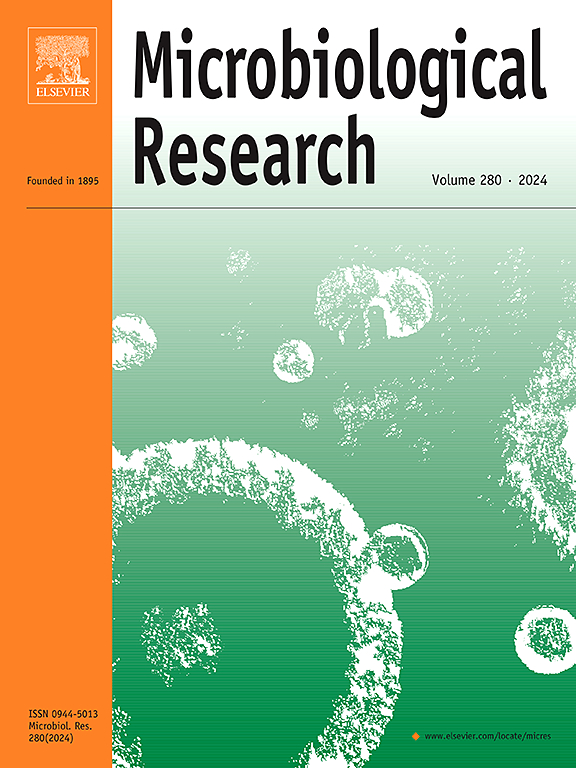Molecular insights from integrated metabolome-transcriptome into endophyte Bacillus subtilis L1-21 surfactin against citrus Huanglongbing
IF 6.1
1区 生物学
Q1 MICROBIOLOGY
引用次数: 0
Abstract
Metabolites of plant and microbial origin have a great influence on plant-microbe interactions. Members from Bacillus subtilis are known to produce a plethora of metabolites that shape plant responses towards biotic and abiotic stresses. Similarly, endophyte B. subtilis L1–21 efficiently controls the Huanglongbing (HLB) causing pathogen: Candidatus Liberibacter asiaticus (CLas). However, the molecular mechanisms are highly elusive. Herein, our study highlights the critical role of endophyte L1–21 in planta-produced surfactin in its colonization in citrus plants and regulation of plant-microbe interactions by comparing three gene knockout mutants △srfAA-L1–21, △sfp-L1–21, and △pel-L1–21. All three mutants exhibited reduced pathogen control and colonization efficiency compared to wild-type (WT) L1–21, but knockout mutant deficient of surfactin △srfAA-L1–21 was significantly impaired in the abovementioned functions as compared to △sfp-L1–21 and △pel-L1–21. Further, △srfAA-L1–21 could not activate various metabolic pathways in citrus as WT-L1–21. Integrated metabolomic-transcriptomic analysis reveals that important secondary metabolites such as flavonoids, volatile organic compounds, and lignins were highly accumulated in citrus plants treated with WT-L1–21 as compared to △srfAA-L1–21, highlighting the role of surfactin as an elicitor of the defense system in citrus-HLB pathosystem. Interestingly, auxin-related metabolites and transcripts were also downregulated in △srfAA-L1–21 compared to WT-L1–21 showing that surfactin might also influence plant-microbe interactions through metabolic reprogramming. Further, higher enrichment of Bacilli with WT-L1–21 might corresponds to surfactin-mediated regulation of community-related behavior in Bacilli. To the best of our knowledge, this is the first study reporting the role of surfactin from Bacillus endophyte in metabolic reprogramming in citrus-HLB pathosystem and mounting defense response against CLas pathogen.
综合代谢组-转录组对内生枯草芽孢杆菌 L1-21 表面活性素防治柑橘黄龙病的分子认识。
源自植物和微生物的代谢物对植物与微生物之间的相互作用有很大影响。众所周知,枯草芽孢杆菌(Bacillus subtilis)成员能产生大量代谢物,这些代谢物能影响植物对生物和非生物胁迫的反应。同样,内生菌枯草杆菌 L1-21 能有效控制黄龙病(HLB)病原体:黄龙病(HLB)的病原体:亚洲自由杆菌(CLas)。然而,其分子机制却非常难以捉摸。在此,我们的研究通过比较三种基因敲除突变体△srfAA-L1-21、△sfp-L1-21和△pel-L1-21,强调了内生菌L1-21在柑橘植物中定植和调控植物与微生物相互作用过程中产生的表面活性素的关键作用。与野生型(WT)L1-21相比,这三种突变体都表现出病原体控制和定殖效率降低,但与△sfp-L1-21和△pel-L1-21相比,缺乏表面活性素的基因敲除突变体△srfAA-L1-21在上述功能上明显受损。此外,△srfAA-L1-21不能像WT-L1-21那样激活柑橘的各种代谢途径。代谢组-转录组综合分析表明,与△srfAA-L1-21相比,WT-L1-21处理的柑橘植株中黄酮类、挥发性有机化合物和木质素等重要次生代谢物的积累量较高,这突出表明了表面活性素在柑橘-HLB病理系统中作为防御系统诱导剂的作用。有趣的是,与 WT-L1-21 相比,△srfAA-L1-21 中的辅助素相关代谢物和转录物也出现了下调,这表明表面活性剂也可能通过代谢重编程影响植物与微生物之间的相互作用。此外,WT-L1-21 对芽孢杆菌的富集程度较高,这可能与表面活性素介导的芽孢杆菌群落相关行为的调控相对应。据我们所知,这是首次报道来自内生芽孢杆菌的表面活性素在柑橘-HLB病理系统的代谢重编程和对 CLas 病原体的防御反应中的作用。
本文章由计算机程序翻译,如有差异,请以英文原文为准。
求助全文
约1分钟内获得全文
求助全文
来源期刊

Microbiological research
生物-微生物学
CiteScore
10.90
自引率
6.00%
发文量
249
审稿时长
29 days
期刊介绍:
Microbiological Research is devoted to publishing reports on prokaryotic and eukaryotic microorganisms such as yeasts, fungi, bacteria, archaea, and protozoa. Research on interactions between pathogenic microorganisms and their environment or hosts are also covered.
 求助内容:
求助内容: 应助结果提醒方式:
应助结果提醒方式:


